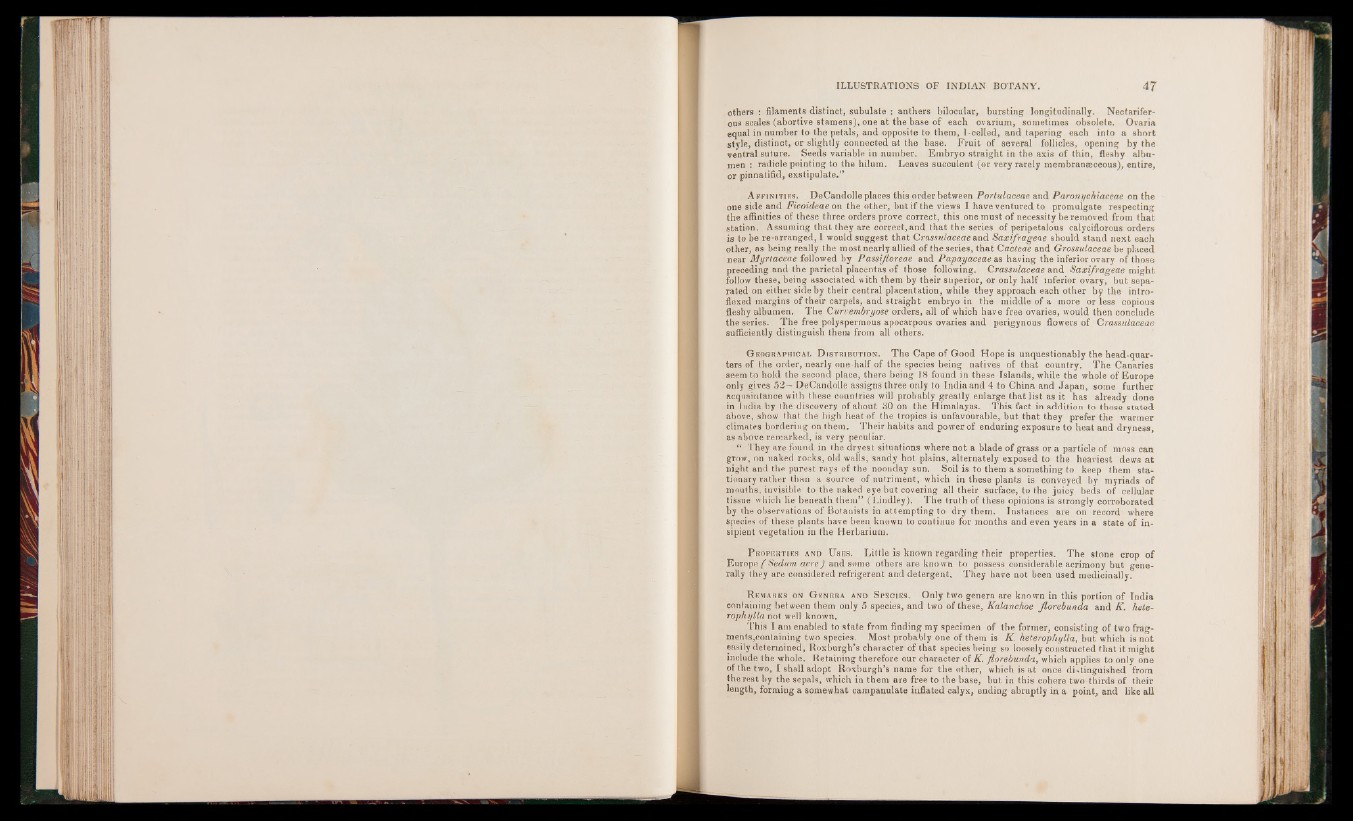
others : filaments distinct, subulate : anthers bilocular, bursting longitudinally. Nectariferous
scales (abortive stamens), one at the base of each ovarium, sometimes obsolete. Ovaria
equal in number to the petals, and opposite to them, 1-celled, and tapering each into a short
style, distinct, or slightly connected at the base. Fruit of several follicles, opening by the
ventral suture. Seeds variable in number. Embryo straight in the axis of thin, fleshy albumen
: radicle pointing to the hilum. Leaves succulent (or very rarely membraneeceous), entire,
or pinnatifid, exstipulate.”
A f fin it ie s. DeCandolle places this order between Portulaceae and Paronychiaceae on the
one side and Ficoideae on the other, but if the views I have ventured to promulgate respecting
the affinities of these three orders prove correct, this one must of necessity be removed from that
station. Assuming that they are correct, and that the series of peripetalous calyciflorous orders
is to be re-arranged, I would suggest that Crassulaceae and Saxifrageae should stand next each
other, as being really the most nearly allied of the series, that Cacteae and Grossulaceae be placed
near Myrtaceae followed by Passijioreae and Papayaceae as having the inferior ovary of those
preceding and the parietal placentas of those following. Crassulaceae and Saxifrageae might
follow these, being associated with them by their superior, or only half inferior ovary, but separated
on either side by their central placentation, while they approach each other by the intro-
flexed margins of their carpels, and straight embryo in the middle of a more or less copious
fleshy albumen. The Curvembryose orders, all of which have free ovaries, would then conclude
the series. The free polyspermous apocarpous ovaries and perigynous flowers of Crassulaceae
sufficiently distinguish them from all others.
G eographical D istribution. The Cape of Good Hope is unquestionably the head-quarters
of the order, nearly one-half of the species being natives of that country. The Canaries
seem to hold the second place, there being 18 found in these Islands, while the whole of Europe
only gives 52— DeCandolle assigns three only to India and 4 to China and Japan, some further
acquaintance with these countries will probably greatly enlarge that list as it has already done
in India by the discovery of about 30 on the Himalayas. This fact in addition to those stated
above, show that the high heat of the tropics is unfavourable, but that they prefer the warmer
climates bordering on them. Their habits and power of enduring exposure to heat and dryness,
as above remarked, is very peculiar.
“ They are found in the dryest situations where not a blade of grass or a particle of moss can
grow, on naked rocks, old walls, sandy hot plains, alternately exposed to the heaviest dews at
night and the purest rays of the noonday sun. Soil is to them a something to keep them stationary
rather than a source of nutriment, which in these plants is conveyed by myriads of
mouths, invisible to the naked eye but covering all their surface, to the juicy beds of cellular
tissue which lie beneath them” (Lindley). The truth of these opinions is strongly corroborated
by the observations of Botanists in attempting to dry them. Instances are on record where
species of these plants have been known to continue for months and even years in a state of in-
sipient vegetation in the Herbariuln.
P roperties and U ses. Little is known regarding their properties. The stone crop of
Europe ( Sedum acre) and some others are known to possess considerable acrimony but generally
they are considered refrigerent and detergent. They have not been used medicinallv.
R emarks on G enera and S pecies. Only two genera are known in this portion of India
containing between them only 5 species, and two of these, Kalanchoe florebunda and AT. hete-
rophylla not well known.
This I am enabled to state from finding my specimen of the former, consisting of two fragments,
containing two species. Most probably one of them is K. heterophylla, but which is not
easily determined, Roxburgh’s character of that species being so loosely constructed that it might
include the whole. Retaining therefore our character of K. florebunda, which applies to only one
of the two, I shall adopt Roxburgh’s name for the other, which is at once distinguished from
the rest by the sepals, which in them are free to the base, but in this cohere two thirds of their
length, forming a somewhat campanulate inflated calyx, ending abruptly in a point, and like all